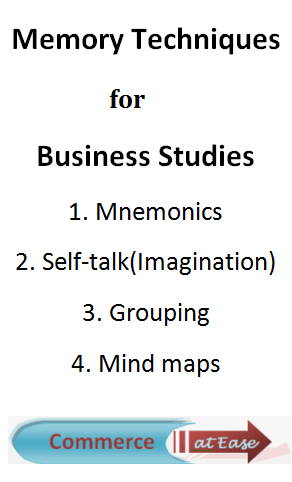Memory Techniques for Business Studies
 For learning Business Studies though detailed study of the topics is required, there are some simple techniques to remember points. In some cases, the points need to be learnt in sequence and in some other cases points can be arranged in any order as per your convenience.
For learning Business Studies though detailed study of the topics is required, there are some simple techniques to remember points. In some cases, the points need to be learnt in sequence and in some other cases points can be arranged in any order as per your convenience.
Whatever may be the case, the following techniques can be used easily and used as per your interest:
Mnemonics
Mnemonics is a technique used to remember the things in a simpler and better way. Using the first alphabet of the words used and arranging them to make a meaningful way, is the most common method of using mnemonics. Here are some examples of use of such mnemonics to learn topics in Business Studies:
1. Functions of Management: POSDiC
Planning
Organizing
Staffing
Directing
Controlling
2. Principles of Management, given by Henry Fayol : DADUU SIR S SE CEO
Division of work
Authority and responsibility
Discipline
Unity of command
Unity of direction
Scalar chain
Initiative
Remuneration
Subordination of individual interest to general interest
Stability of personnel
Equity
Centralization
Esprit de corps
Order
3. Elements of Delegation: ARA
Authority
Responsibility
Accountability
4. Elements of Directing: SuLeCoM
Supervision
Leadership
Communication
Motivation
5. Dimensions of Business Environment: LETSPlay or PESTL
Legal Environment
Economic Environment
Technological Environment
Sociological Environment
Political Environment
Self-Talk (Imagination)
You can weave a sentence or a small story to correlate the points in an interesting, meaningful and simple manner, like in the following cases:
1. Basic features of Profession:
People crossing a well (well defined body of knowledge), then jumping a wall (restricted entry), to enter a field (professional association), to provide some services (service motive) following some rules (code of conduct) and charging fees.
1. Well-defined body of knowledge
2. Restricted entry
3. Professional association
4. Code of conduct
5. Service motive and charging fees
2. Features of Planning
An untiring manager sitting on a chair, focuses his attention, to decide a path to be followed to reach a distant goal.
1. untiring manager.... Continuous process.
2. sitting on a chair.....at every level.......Pervasiveness.
3. focuses his attention..... Mental activity (intellectual process).
4. to decide......Decision making process.
5. to decide.......Judgment (intellectual process).
6. a path to be followed.......Choice of best possible alternative.
7. distant...Futuristic (future oriented process).
8. Goal......Goal oriented process.
3. Leadership Qualities
Using your imagination, you can develop the qualities of a good leader by considering a Human Body:
Head.....Responsibility, knowledge intelligence, decision making, judgment, etc.
Forehead......Intuition, Boldness, Farsightedness, etc.
Eyes.....Having knowledge of surroundings, general awareness, supervision, etc.
Ears.....Patience, listening his subordinates, communication skills, etc.
Nose......Understanding the situation without express knowledge, judgment, etc.
Lips....Command, communication skills, problem solving etc.
Neck.....Rotation of neck indicates flexibility in his approach, etc.
Arms and Legs....Work, he should be actively involved in management process, etc.
And many more........
Grouping the points/ items
Different points to be remembered can be grouped on the basis of some similarity, like in the following case:
External Sources of Recruitment
1. Direct recruitment
2. Recommendation of employees
3. Labour contractors.
4. Management consultants and placement agencies
5. Employment exchanges
6. Advertising (newspaper, journals and magazines, television.)
7. Web publishing
8. Campus recruitment
9. Casual Callers
First group 1-5, then 6-7, then 8 and then last 9
This way an easy and interesting pattern can be set to learn all these.
Students can develop their own such methods to make the learning interesting and long lasting.
